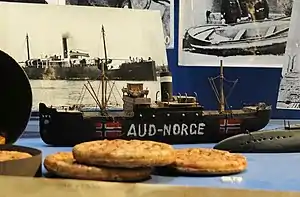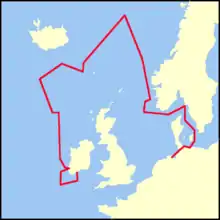SS Libau
Libau (pronounced [lɪˈbaʊ]; also known as SS Castro) was a merchant steam ship. In 1916 it masqueraded under the cover name of Aud ([ʔaʊ̯d]) in an attempt to carry arms from Germany to Ireland as part of the preparation for the Easter Rising.[1]
 Model of the vessel displayed at the Cork Public Museum | |
| History | |
|---|---|
| Name: | SS Castro |
| Laid down: | 1907 |
| Fate: | Captured by Imperial German Navy 1914 |
| Name: | Libau (Aud) |
| Acquired: | 1914 |
| Fate: | Scuttled 1916 |
| Wreck site: | Off Daunt Rock, Cork 51.71°N 8.24°W |
| General characteristics | |
| Type: | Merchant vessel |
| Tonnage: | 1,228 GRT |
| Length: | 220 ft (67 m) |
| Beam: | 32 ft (9.8 m) |
| Draught: | 12 ft (3.7 m) |
| Speed: | 10 knots (19 km/h; 12 mph) |
Vessel
SS Castro was a 1,062 ton steam cargo transport built for the Wilson Line of Hull, England in 1907. Castro measured 220 feet (67 m) in length with a beam 32 feet (9.8 m) and a draught of 12 ft (3.7 m). The ship was captured by the Imperial German Navy in the Kiel Canal, at the beginning of World War I in August 1914. Renamed Libau (the German name of Liepāja), she remained inactive until 1916, when designated as the vessel to carry a cargo of arms to Ireland, to aid the Easter Rising, and given the name Aud.
Smuggling operation

Masquerading as SS Aud — an existing Norwegian vessel of similar appearance — Libau set sail from the Baltic port of Lübeck on 9 April 1916, under the command of Karl Spindler, bound for the south-west coast of Ireland. Under Spindler was a crew of 22 men, all of whom were volunteers. Libau, laden with an estimated 20,000 rifles, 1,000,000 rounds of ammunition, 10 machine guns, and explosives (under a camouflage of a timber cargo), evaded patrols of both the British 10th Cruiser Squadron and local auxiliary patrols.
After surviving violent storms off Rockall, Libau arrived in Tralee Bay on Holy Thursday, 20 April. There they were due to meet with Roger Casement, who had negotiated the arms transfer, but as they had no radio on board the ship, they were unaware that the Kerry volunteers had been told to meet the ship on Easter Sunday off Fenit pier.
On Good Friday, 21 April, the Libau was approached by three British destroyers and attempted to leave the area, but was cornered.[2] Captain Spindler allowed himself to be escorted towards Cork Harbour, in the company of the Acacia-class sloop HMS Bluebell. The German crew then scuttled the ship to keep the weapons from falling into British hands.[3]
Spindler and crew were interned for the duration of the war.[4]
Although Casement had been landed by the submarine U-19 in Banna Strand that Friday, he was captured and arrested, without ever meeting the Libau. Four months later he was tried and hanged as a traitor by the British government.'[5]
One of the two car-loads of volunteers who were supposed to meet Spindler had crashed into the River Laune, many miles away, at Ballykissane pier, Killorglin (resulting in the death of three of the four occupants of the car). So there had been no possibility of an organised transfer of arms.
Artefacts
"Aud rifles"
A number of rifles were recovered from Libau before the vessel was scuttled. Several examples exist in various museums in Britain and Ireland. Among these are the Cork Public Museum in Fitzgerald's Park in Cork, a museum in Lurgan County Armagh, the National Museum of Ireland in Dublin, and the Imperial War Museum in London. The majority of them are the model known as the Mosin–Nagant 1891, or "three-line rifle", captured in the German rout of Russian forces in the Battle of Tannenberg.
The different calibre of these rifles meant they were not attractive for issuing to German troops, for logistical reasons, and through the misunderstanding of this point they have since been widely described as 'outmoded and out of date.'[6] In actuality, the Allies manufactured a great quantity of the rifles during the First World War. A slightly modified (M91/30) version continued to be used by European national armies through World War II and beyond.
The Mosin–Nagant was a magazine rifle, enabling the user to pre-load five rounds from a clip plus, if needed, one more in the breech, and then fire accurately in reasonably rapid succession, using relatively modern .30 calibre (7.62×54mmR) spitzer-nosed bullets. Per Russian preference, the rifles aboard Libau were equipped with the Russian model of socket bayonets, s.c. "Rat-tails".
References
- Pollard, H.B.C. (2003) [1922]. Secret Societies of Ireland, Their Rise and Progress. Kessinger. p. 147. ISBN 0-7661-5479-3.
- "Good Friday In Kerry". RTÉ Archives. Retrieved 8 March 2019.
- "Black night in Ballykissane". The Kingdom. 13 April 2006. Archived from the original on 30 June 2007. Retrieved 1 July 2008.
- Hickey, D.J.; Doherty, J.E. (1980). A Dictionary of Irish History. Dublin: Gill and Macmillan. p. 20. ISBN 0-7171-1567-4.
- "The Easter Rising, my grandfather and the untold story of Sir Roger Casement". The Independent. 1 April 2016. Retrieved 8 March 2019.
- Hackey, Thomas; Hernon, McCaffrey (1996). The Irish Experience: A Concise History. Ireland: M. E. Sharpe. p. 157. ISBN 1-56324-792-5.
- AUD Anchors 1916-2016 Centenary Commemoration Project, Laurence Dunne Archaeology, retrieved 26 March 2017
- Dive sites - Cork Harbour - Aud (bow), UCC Subaqua Club, retrieved 26 March 2017
- "Anchors recovered from arms-smuggling vessel scuttled in plan to aid Easter Rising". The Irish Times. 20 June 2012. Retrieved 30 June 2012.
- "1916 Rising ship 'Aud' anchors to go on display". CoastMonkey.ie. 16 March 2016. Retrieved 26 March 2017.
Further sources and reading
- de Courcy Ireland, Dr John (1966). The Sea and the Easter Rising. Dublin: Maritime Institute of Ireland.
- Xander Clayton: AUD, Plymouth (GAC) 2007, ISBN 978-0-9555622-0-4
- Spindler, Karl; Montgomery, W.; McGrath, E.H. (1921). Gun Running for Casement in the Easter Rebellion, 1916. London: Collins. Retrieved 16 November 2015.